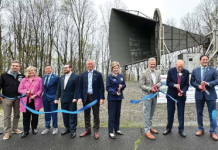By Gretchen C. Van Benthuysen |
The three Lee children grew up in the 1960s and ’70s in a house overlooking the Navesink River just east of Riverview Hospital.
“When we were very young we would see mossbunker fish runs and snappers, egrets, cormorants and ducks,” Nancy Lee said. “We very much appreciated nature and how beautiful it was.
“That experience was formative for all of us,” she added. “We were near the ocean. We loved boat rides. We fished, sailed, skied.”
As they grew older, though, they noticed changes in the river. It was more polluted. The fish died off and jellyfish took over. And the water level of the Navesink seemed to be rising.
At the time, the usual approach for protecting waterfront property was to build a bulkhead.
“Our father, Norman Lee, built our bulkhead above the high tide line in the late 1960s,” Mary Lee said. “Now the water is up to the bulkhead even at low tide. It’s very clear the sea level has risen and the river is now eroding the shoreline and property above it.”
Instead of replacing the bulkhead, the Lee family will stabilize the area with a sill, a continuous rock structure parallel to the shore that acts as a natural buffer so a marsh with vegetation can be established behind it to restore the shoreline. The project will be partially paid for with a $10,000 grant from The Nature Conservancy in New Jersey through its Living Shoreline Grants Program, which provides money for nature-based community resilience projects.
The project has the potential to be a model for other private landowners in New Jersey to consider living shorelines instead of bulkheads, the Nature Conservancy stated.
Mary Lee, 59, a physician, Nancy Lee, 66, an international economist, and Gregory Lee, 70, a naval architect, all own the Red Bank house.
“If we do nothing we will simply lose part of the property,” explained Nancy. “The idea is not to keep water and waves out of the wetlands or living shoreline. It’s to allow the water to flow over the wetlands and seep into the ground.
“The plants that are used for a living shoreline can tolerate exposure to salt and water,” she said. They also act like shock absorbers.”
“One part of the living shoreline design will be to construct breakwaters that reduce the amount of wave energy experienced by the shoreline directly behind it,” Mary explained. “The breakwater doubles as habitat for shell fish, including oysters and mussels. These, in turn, act as a filtration system to clean the water.”
Oysters also build vertical “castles” that help break wave action.
When the family decided not to rebuild the bulkhead, Mary contacted Princeton Hydro, a 20-year-old ecological nature-based consulting company in East Amwell Township.
Geoffrey M. Goll, president, principal engineer and founder, said working with a private homeowner is unique. Usually the company works with homeowners associations and county and municipal governments.
Mark Gallagher, vice president and founder, is in charge of the Lee’s project. He coordinates with the U.S Fish & Wildlife Service and the Jersey Department of Environmental Protection, which recommended the grant.
The first phase is to design the project, which must be approved by the Army Corp of Engineers, then request permits. Phase two is the construction. Gallagher hopes to start work early next year.
“The types of shoreline treatments can vary significantly based on the location of a given project,” Gallagher explained. “However, many projects that require some type of wave attenuation structure – such as a rock breakwater or oyster castle in combination with vegetation – would fall within a range of $480 to $650 per linear foot.”
In comparison, a 3-foot high bulkhead costs about $250 per linear foot and a 12-foot high bulkhead $1,200 per linear foot, said a spokesperson for the Fair Haven-based marine contractor Rice Associates Inc., but materials and location can make a difference. For example, the riverbed may require a 35-foot piling in one place and 45-foot pilings in another.
Goff called it a “good program” and hopes grants will continue to be offered.
Pat Doerr, Director of Coastal Programs in New Jersey for the Nature Conservancy said future funding is “unclear.”
“It’s new this year and there’s been a high amount of interest,” she said, adding nature conservancies in other states also offer grants.
Eighteen projects in New Jersey were submitted by the May 2018 deadline and $75,000 was awarded to projects in four communities. Besides the Lee family’s project, grants went to Ship Bottom – $35,000 to build a hybrid living shoreline; Beach Haven – $20,000 to Mordecai Land Trust to expand an existing oyster castle breakwater that helps protect Mordecai Island; and Waretown – $10,000 to Lighthouse Center for Natural Resource Education, to design and construct a hybrid living shoreline.
“We’re a small part of the shore life on the Navesink,” Nancy said. “While bulkheads have been the usual approach for waterfront properties, shoreline erosion is occurring on our property due to the rising level of the river.
“Our installation of a living shoreline can serve as a demonstration project,” she said. “Climate change is not an abstract concept for us.”
“Over the years we’ve seen the erosion of the shoreline, changes in the river, the sea level rise, and the effects of pollution on birds and animals living near the river,” said Nancy. “We would like to restore the shoreline we have lost on our property and help restore the natural habitat for wildlife that used to be there on the river. We also hope this is a more permanent solution that others will consider.”
This article was first published in the Nov. 1-7, 2018 print edition of The Two River Times.














